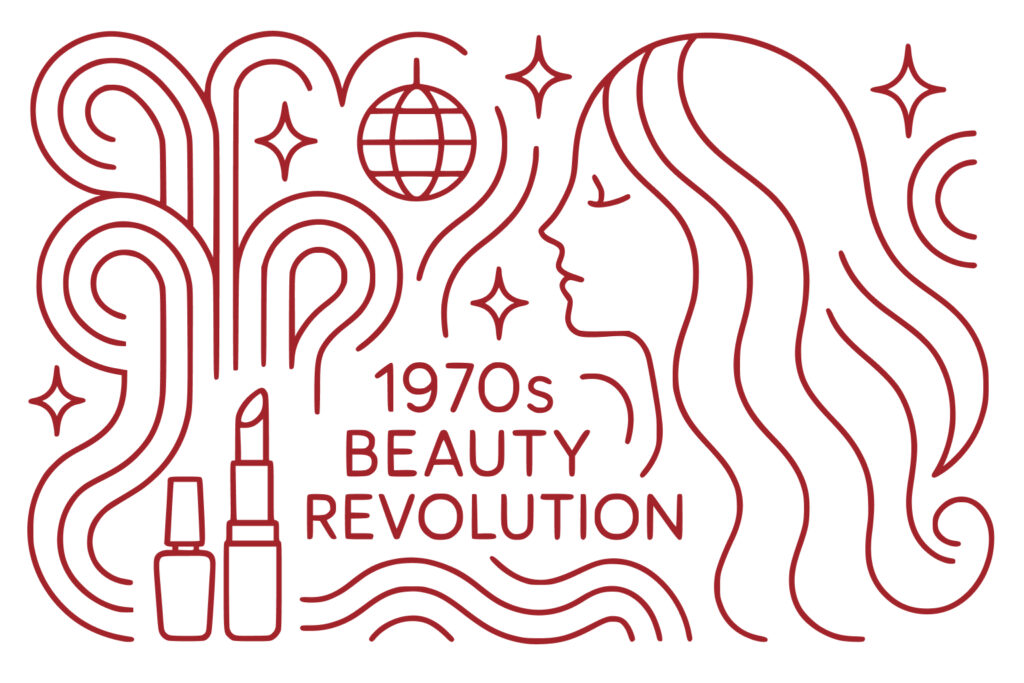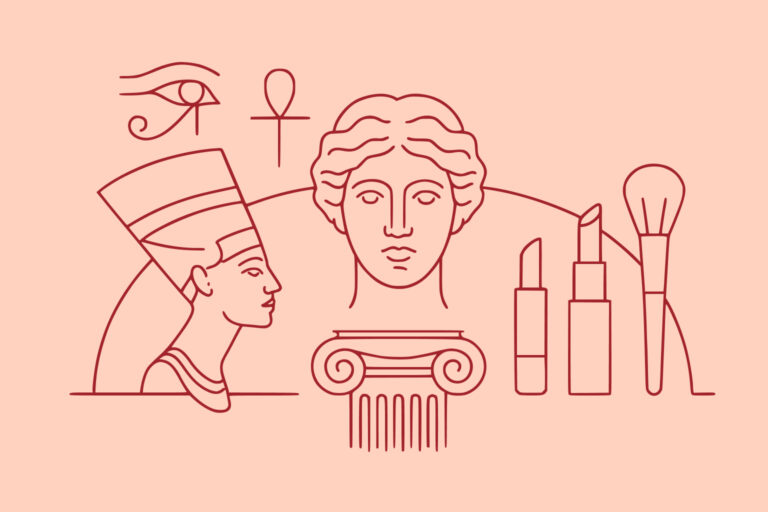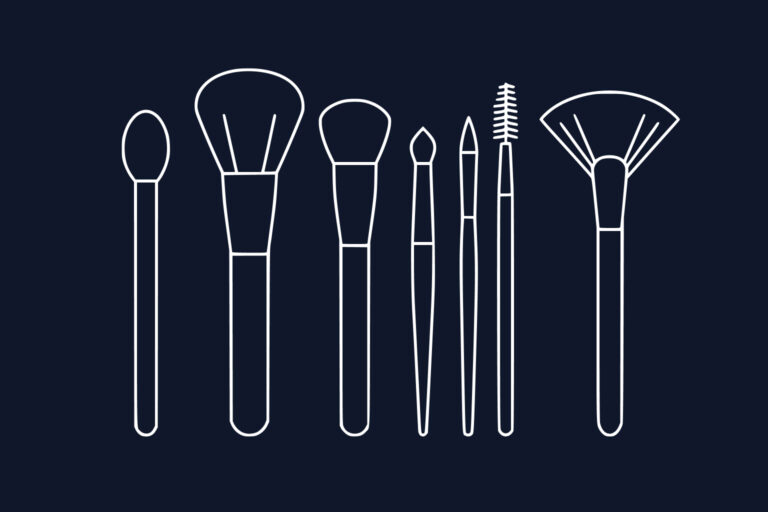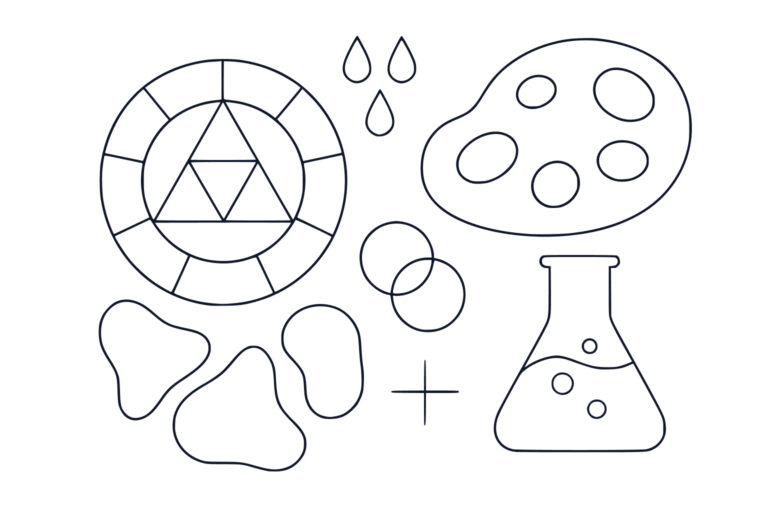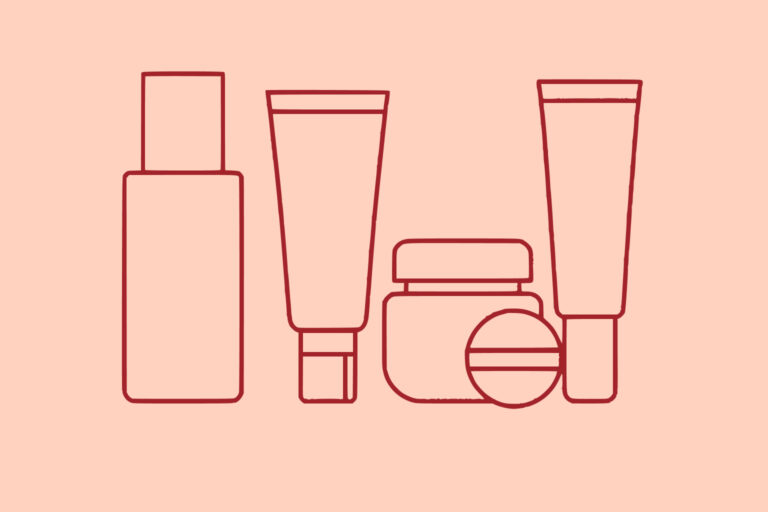1970s Beauty Revolution: From Hippie Natural to Disco Glamour
Published by Professional Makeup Artist London
The 1970s witnessed one of the most diverse and contradictory decades in beauty history, spanning from the natural, anti-establishment aesthetics of the hippie movement to the glamorous excess of disco culture. This decade rejected the geometric precision of the 1960s mod movement in favour of two distinctly different approaches: authentic naturalism and theatrical glamour. The period’s beauty trends reflected broader social changes, including environmental consciousness, women’s liberation, multiculturalism, and the emergence of celebrity culture. Understanding this complex decade reveals how political movements, social change, and cultural diversity can simultaneously influence beauty standards in seemingly contradictory directions.
The Hippie Movement: Embracing Natural Beauty
The late 1960s and early 1970s hippie movement fundamentally challenged conventional beauty standards by rejecting artificial enhancement in favour of natural, unprocessed appearance. This represented a direct rebellion against the heavily made-up looks that had dominated previous decades.
Hippie beauty philosophy emphasised authenticity and rejection of commercial beauty standards. The movement viewed elaborate makeup and styled hair as symbols of conformity and materialism, preferring instead to celebrate natural features and textures.
The “no-makeup makeup” look that emerged from hippie culture required subtle techniques that enhanced natural features without obvious artifice. This involved using minimal foundation, earth-toned eyeshadows, and lip colours that appeared natural whilst actually improving upon nature.
Skincare became more important than makeup during this period, with emphasis on healthy, glowing skin achieved through natural methods. The hippie movement promoted holistic approaches to beauty that included diet, exercise, and natural skincare ingredients.
Hair care reflected the movement’s natural philosophy, with long, unstyled hair becoming a symbol of freedom and authenticity. The rejection of chemical processing, elaborate styling, and artificial enhancement represented a fundamental shift in beauty values.
The influence of Eastern philosophy and alternative spirituality on hippie culture extended to beauty practices, with many adopting Ayurvedic and traditional herbal approaches to skincare and cosmetics.
Understanding how social movements influence beauty standards provides valuable context for modern approaches to natural makeup application and authentic self-expression.
Earth Tones and Natural Palettes
The 1970s introduced earth-toned colour palettes that reflected the decade’s environmental consciousness and connection to nature. These colours represented a dramatic departure from the stark contrasts and artificial hues of the previous decade.
Brown became the decade’s signature colour, appearing in eyeshadows, eyeliners, and lip colours that created warm, natural-looking effects. Various shades of brown—from light taupe to deep chocolate—allowed for sophisticated colour gradation and natural-looking enhancement.
Warm orange and rust tones gained popularity as accent colours that complemented the brown-based palette. These colours worked particularly well with the tanned skin that became fashionable during this period.
Green tones, from olive to forest green, reflected the environmental movement’s influence on beauty culture. These colours were often used subtly to enhance eye colour or create natural-looking definition.
Gold and bronze metallic finishes provided glamour whilst maintaining connection to natural elements. These colours bridged the gap between hippie naturalism and the emerging disco aesthetic.
The decade’s colour palette extended to hair, with natural-looking highlights and lowlights that mimicked the effects of sun exposure becoming popular alternatives to obvious artificial colouring.
Understanding how cultural movements influence colour selection and palette development provides insights for contemporary makeup artistry and trend forecasting.
The Farrah Fawcett Phenomenon: Feathered Hair Revolution
Farrah Fawcett’s iconic feathered hairstyle became the decade’s most influential beauty trend, representing a perfect synthesis of natural texture and glamorous styling that appealed to both hippie and mainstream sensibilities.
The feathered cut featured layered hair that was blown back from the face using a round brush and hair dryer, creating volume and movement that appeared both natural and polished. This style required significant skill to execute properly and maintain at home.
The technique for creating feathered hair involved precise layering that allowed the hair to fall naturally whilst maintaining the characteristic swept-back shape. This required understanding of hair growth patterns and face shapes to achieve flattering results.
Feathered hair represented a democratisation of glamour, as the style could be adapted for different hair types and lengths whilst maintaining its essential character. This accessibility contributed to its widespread adoption across different social groups.
The maintenance of feathered hair required daily styling with blow dryers and round brushes, representing a middle ground between the elaborate salon styles of the 1950s and the unstyled natural hair of the hippie movement.
Hair care products evolved to support feathered styling, with new mousse and styling aids that provided hold whilst maintaining natural movement and texture.
The influence of Farrah Fawcett’s hairstyle extended beyond specific techniques to establish new standards for celebrity influence on beauty trends that continue to shape contemporary culture.
The Emergence of Disco Glamour
The mid-to-late 1970s saw the emergence of disco culture, which brought theatrical glamour and dramatic makeup back into fashion after years of natural, understated beauty trends.
Studio 54 and other famous nightclubs became laboratories for experimental beauty looks that emphasised drama, glamour, and individual expression. The club environment demanded makeup that would look striking under coloured lights and maintain its impact throughout long nights of dancing.
Disco makeup featured bold colours, metallic finishes, and dramatic application techniques that created looks suitable for the theatrical environment of nightclub culture. This represented a complete reversal from the natural aesthetics that had dominated the early 1970s.
Glitter and metallic eyeshadows became central to disco beauty, with silver, gold, and iridescent colours creating the reflective effects that worked well under disco lighting. These finishes required new application techniques and setting methods to maintain their impact.
False eyelashes made a comeback during the disco era, often in dramatic styles that created bold, theatrical effects. The application and maintenance of these lashes required skill and practice to achieve professional-looking results.
Contouring techniques became more sophisticated during the disco period, with makeup artists using highlighting and shading to create dramatic facial structure that would be visible under club lighting conditions.
The disco movement’s influence on beauty culture established precedents for how nightlife and entertainment venues could drive beauty trends and innovation.
Multicultural Influences and Beauty Diversity
The 1970s marked the beginning of increased recognition and celebration of diverse beauty standards, with influences from African, Latino, and Asian cultures beginning to impact mainstream beauty trends.
The Black is Beautiful movement of the late 1960s and early 1970s influenced broader beauty culture by celebrating natural African hair textures and promoting makeup techniques that enhanced rather than concealed ethnic features.
Afro hairstyles gained mainstream acceptance and influence, with natural hair textures being celebrated rather than chemically processed to conform to European standards. This represented a significant shift in beauty culture and social attitudes.
Makeup techniques developed specifically for darker skin tones began to influence mainstream cosmetics, with improved foundation ranges and colour selections that served previously underserved markets.
The influence of international fashion and beauty began to increase during this period, with designers and makeup artists drawing inspiration from global traditions and techniques.
Cultural exchange through music, fashion, and media introduced new beauty concepts and techniques that enriched the decade’s diverse aesthetic landscape.
This increased diversity in beauty standards established foundations for the multicultural approach to cosmetics that characterises contemporary beauty culture.
The Tanning Revolution
The 1970s witnessed a dramatic shift in skin tone preferences, with tanned skin becoming fashionable for the first time in Western beauty culture. This change reflected broader social attitudes about leisure, health, and natural beauty.
The popularity of tanned skin represented a complete reversal from centuries of beauty culture that had prized pale complexions as symbols of refinement and social status. This change reflected new associations between tanned skin and health, leisure, and natural beauty.
Tanning methods evolved during this period, with the development of tanning oils, reflective devices, and early self-tanning products that allowed people to achieve bronzed skin more safely and conveniently.
Makeup techniques adapted to complement tanned skin, with new foundation shades, bronzing products, and colour palettes that enhanced rather than covered natural or artificial tans.
The tanning trend influenced fashion and lifestyle choices, with clothing styles and colours selected to complement bronzed skin tones and emphasise the healthy, outdoorsy image that tanned skin represented.
Hair colouring trends also adapted to complement tanned skin, with sun-streaked highlights and natural-looking colour variations that mimicked the effects of sun exposure becoming popular.
Makeup Application Techniques and Innovation
The 1970s saw significant evolution in makeup application techniques as artists adapted to serve both natural and glamorous aesthetic demands within the same decade.
Blending techniques became more sophisticated during this period, particularly for eyeshadow application that required seamless gradations from light to dark tones. This was essential for achieving the natural-looking enhancement that characterised early 1970s beauty.
Contouring methods evolved to create more natural-looking dimension, moving away from the flat, graphic effects of the 1960s towards techniques that enhanced facial structure whilst maintaining realistic appearance.
The application of earth-toned eyeshadows required understanding of colour theory and blending techniques that created depth and dimension without obvious artifice. This demanded higher levels of technical skill than previous decades’ simpler colour applications.
Highlighting techniques developed to complement the decade’s emphasis on healthy, glowing skin. These methods used light-reflecting products to create natural-looking luminosity that enhanced the tanned complexions that were fashionable.
Lip application techniques adapted to accommodate both the natural looks of early 1970s and the more dramatic effects required for disco glamour, requiring versatility and adaptability from makeup artists.
Understanding these technical developments provides valuable context for modern contouring and highlighting techniques that emphasise natural enhancement.
Hair Styling Revolution and Technical Innovation
The 1970s brought significant innovations in hair styling tools and techniques that supported the decade’s diverse range of hairstyles from natural textures to elaborate feathered styles.
The blow dryer became an essential tool during this period, allowing for the volume and movement that characterised feathered hair and other popular styles. This represented a shift towards home styling that reduced dependence on professional salon services.
Hot rollers and curling irons evolved to provide better heat control and more versatile styling options. These tools allowed for the creation of the loose, natural-looking curls that were popular throughout the decade.
Hair care products expanded to include mousses, gels, and styling aids that provided hold whilst maintaining natural movement and texture. These products supported the decade’s preference for styles that appeared effortless whilst actually requiring considerable technique to achieve.
Cutting techniques evolved to support the layered styles that dominated the decade, with stylists developing methods for creating the precise layering that allowed hair to fall naturally whilst maintaining desired shapes.
Colour techniques became more sophisticated, with highlighting and lowlighting methods that created natural-looking variation and dimension. These techniques required advanced understanding of colour theory and application methods.
The democratisation of hair styling through improved home tools and techniques established patterns that continue to influence contemporary hair care and styling practices.
Celebrity Influence and Media Impact
The 1970s saw the emergence of modern celebrity culture, with television, film, and music stars having unprecedented influence on beauty trends and consumer behaviour.
Television’s growing influence on popular culture affected beauty trends, with stars like Farrah Fawcett, Dorothy Hamill, and Cher establishing looks that were widely copied by mainstream consumers.
The emergence of music television and concert footage brought new visibility to performer makeup and hairstyles, with rock and disco stars influencing beauty trends through their stage appearances.
Fashion magazines expanded their beauty coverage during this period, with publications like Vogue and Harper’s Bazaar featuring more detailed makeup and hair tutorials that helped spread professional techniques to home users.
The influence of international celebrities began to increase during this period, with stars from different countries and cultures contributing to the decade’s diverse beauty landscape.
Celebrity endorsement of beauty products became more common and influential during the 1970s, establishing marketing patterns that continue to dominate contemporary cosmetics promotion.
Understanding how celebrity culture influences beauty trends provides valuable insights for contemporary makeup artists working with media and public figures.
Product Development and Industry Evolution
The 1970s brought significant innovations in cosmetic formulation and packaging that supported the decade’s diverse beauty requirements and changing consumer expectations.
Foundation technology advanced to provide better colour matching for diverse skin tones, reflecting the decade’s increased awareness of multicultural beauty needs. This included expanded shade ranges and improved formulations for different skin types.
Eyeshadow formulations improved to provide better blendability and colour payoff, essential for achieving the sophisticated gradations that characterised 1970s eye makeup. New pressing techniques and ingredient combinations created products with superior performance characteristics.
Hair care products evolved significantly during this period, with new formulations designed to support both natural textures and styled looks. This included products for enhancing curl, providing volume, and maintaining colour-treated hair.
Packaging design reflected the decade’s diverse aesthetic influences, with some products featuring natural, earth-toned designs whilst others embraced the glamorous metallics and bold graphics associated with disco culture.
The beauty industry’s marketing strategies evolved to address different consumer segments simultaneously, with product lines designed to serve both natural beauty enthusiasts and glamour seekers within the same brand portfolios.
These innovations established many of the product categories and performance standards that define modern cosmetic formulation and development.
Social and Cultural Impact
The beauty trends of the 1970s reflected and influenced broader social changes that transformed Western culture during this pivotal decade.
The women’s liberation movement influenced beauty culture by promoting individual choice and rejecting prescribed beauty standards. This led to greater diversity in acceptable looks and increased emphasis on personal expression over conformity.
Environmental consciousness affected beauty product development and consumer choices, with increased interest in natural ingredients and sustainable practices. This established foundations for the clean beauty movement that continues today.
The decade’s economic challenges influenced beauty spending patterns, with consumers seeking products that offered versatility and value. This led to innovations in multi-purpose products and more accessible luxury alternatives.
Changing social attitudes about sexuality and self-expression influenced beauty trends, with both natural and glamorous looks serving as forms of personal and political statement.
The period’s emphasis on authenticity and individual expression established new paradigms for beauty culture that continue to influence contemporary trends and consumer behaviour.
International Influence and Global Exchange
The 1970s marked the beginning of truly global beauty culture, with increased international travel, communication, and media exchange spreading trends across cultural boundaries.
European fashion and beauty trends gained increased influence in American markets, with French and Italian approaches to natural beauty and sophisticated glamour affecting mainstream American beauty culture.
The influence of non-Western beauty traditions began to increase during this period, with techniques and ingredients from African, Asian, and Latin American cultures beginning to impact mainstream beauty practices.
International fashion weeks and beauty trade shows became more important for trend development and dissemination, creating global platforms for beauty innovation and cultural exchange.
The emergence of international beauty brands and global marketing strategies began to standardise certain beauty practices whilst also celebrating cultural diversity and local preferences.
This globalisation of beauty culture established patterns of international influence and cultural exchange that continue to shape contemporary beauty trends and industry practices.
Legacy and Modern Influence
The diverse beauty trends of the 1970s continue to influence contemporary makeup and hairstyling, with many techniques and aesthetic principles remaining relevant today.
The decade’s emphasis on natural beauty and authentic self-expression established foundations for contemporary clean beauty and wellness movements. Modern approaches to minimal makeup and natural enhancement draw directly from 1970s innovations.
Feathered hair techniques and layered cutting methods developed during this period remain central to modern hairstyling education and practice. Contemporary stylists study these techniques to understand fundamental principles of movement and texture.
The disco era’s approach to dramatic glamour and theatrical makeup established precedents for contemporary editorial and fashion makeup artistry. Modern artists draw on 1970s techniques for creating bold, impactful looks.
Product innovations from this period, particularly in hair care and foundation formulation, established many of the performance standards that define modern cosmetics.
The decade’s integration of diverse cultural influences and beauty standards created precedents for the multicultural approach that characterises contemporary beauty culture.
Understanding this historical development provides valuable context for contemporary approaches to beauty culture evolution and trend development.
Recreating 1970s Looks Today
Modern makeup artists and beauty enthusiasts can recreate authentic 1970s looks using contemporary products and techniques adapted from historical methods.
Achieving the natural hippie look requires subtle application techniques that enhance features without obvious artifice. Modern products offer better performance than period cosmetics whilst maintaining the authentic, understated effects that defined the style.
The earth-toned eyeshadow looks that characterised the decade can be recreated using contemporary palettes and blending techniques that provide better colour payoff and longer wear than 1970s products.
Feathered hair can be created using modern blow-drying techniques and styling tools that offer better heat control and more precise results than period equipment.
Disco glamour looks can be achieved using contemporary glitter and metallic products that provide better adhesion and longer wear than 1970s formulations whilst maintaining the dramatic effects that defined the style.
Understanding the fundamental principles behind 1970s techniques allows modern artists to adapt these looks for contemporary clients whilst maintaining their essential character and cultural significance.
Conclusion
The 1970s beauty revolution represents one of the most complex and influential periods in cosmetic history, demonstrating how diverse social movements and cultural changes can simultaneously influence beauty standards in seemingly contradictory directions. From hippie naturalism to disco glamour, this decade established new paradigms for individual expression, cultural diversity, and authentic self-presentation that continue to shape contemporary beauty culture.
The period’s innovations in natural makeup techniques, earth-toned colour palettes, and sophisticated hair styling established technical and aesthetic foundations that remain relevant for modern makeup artists and beauty enthusiasts. The decade’s integration of diverse cultural influences and beauty standards created precedents for the inclusive approach that characterises contemporary cosmetics.
Understanding the 1970s beauty revolution provides valuable context for appreciating contemporary trends and techniques. The decade’s emphasis on authenticity, individual expression, and cultural diversity continues to influence how we approach beauty and self-presentation today.
Whether exploring natural enhancement techniques inspired by the hippie movement or dramatic glamour effects drawn from disco culture, the 1970s offers rich inspiration and practical knowledge that remains vital for contemporary beauty practice and cultural understanding.
